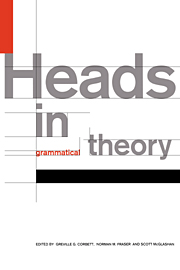Book contents
- Frontmatter
- Contents
- List of contributors
- 1 Introduction
- 2 The head of Russian numeral expressions
- 3 The phonology of heads in Haruai
- 4 Patterns of headedness
- 5 Head-hunting: on the trail of the nominal Janus
- 6 The headedness of noun phrases: slaying the nominal hydra
- 7 Head- versus dependent-marking: the case of the clause
- 8 Heads in discourse: structural versus functional centricity
- 9 Heads in Head-driven Phrase Structure Grammar
- 10 Heads and lexical semantics
- 11 Heads, parsing and word-order universals
- 12 Do we have heads in our minds?
- 13 Heads, bases and functors
- References
- Index
8 - Heads in discourse: structural versus functional centricity
Published online by Cambridge University Press: 23 February 2010
- Frontmatter
- Contents
- List of contributors
- 1 Introduction
- 2 The head of Russian numeral expressions
- 3 The phonology of heads in Haruai
- 4 Patterns of headedness
- 5 Head-hunting: on the trail of the nominal Janus
- 6 The headedness of noun phrases: slaying the nominal hydra
- 7 Head- versus dependent-marking: the case of the clause
- 8 Heads in discourse: structural versus functional centricity
- 9 Heads in Head-driven Phrase Structure Grammar
- 10 Heads and lexical semantics
- 11 Heads, parsing and word-order universals
- 12 Do we have heads in our minds?
- 13 Heads, bases and functors
- References
- Index
Summary
Introduction
Ellipsis, deletability and the question of what fragment of a constituent can stand alone are problems which figure in many discussions of what constitutes the head of a constituent; see Zwicky's definition of base (this volume). The very persistence of this issue in the literature would lead one to expect that there would be distinct cross-linguistic consistency in the deletability and retainability of parts of constituents. In addition, and more generally, it would lead one to expect that the notion of head would lead to useful crosslinguistic generalizations about deletability and obligatoriness of parts of constituents. This chapter offers a first step towards a cross-linguistic investigation of whether and how heads figure in constraining constituent-reducing operations of the type that arise in connected discourse. A comparison of just two of the languages discussed – Russian and Chechen-Ingush – suffices to show that languages can differ substantially in whether heads can be deleted, or dependents left to stand alone, by these discourse operations. In part for this reason, and in part because the relevant tendencies are only statistical, constituent-reducing operations will probably not prove to be a useful cross-linguistic indicator of head and non-head status. On the other hand, they do appear to shed light on some of the larger questions of how constituents are defined, grammaticalized and used in individual languages.
In what follows I will simply assume that the verb is the head of the clause. Since the argument is that there is neither cross-linguistic consistency in what can be deleted in ellipsis nor correlation between deletability and morphological type, the conclusions would be equally valid for any decision as to what is head.
- Type
- Chapter
- Information
- Heads in Grammatical Theory , pp. 164 - 185Publisher: Cambridge University PressPrint publication year: 1993
- 3
- Cited by



